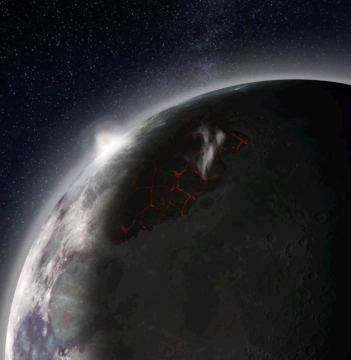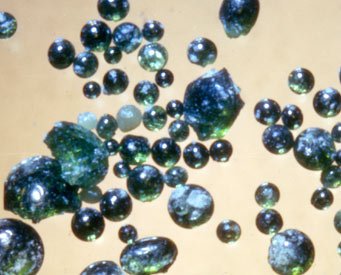Ancient Moon Had Atmosphere Made of Volcano Smoke
Roughly 3.5 billion years ago huge volcanoes released enough gas to cover the Moon with a thin atmosphere that was visible from Earth.
We are used to picturing the Moon as a quiet place of “magnificent desolation,” its otherworldly peace disturbed only by the occasional meteorite impact or rare terrestrial spacecraft landing. But 3 or 4 billion years ago, it might have looked very different.
After forming around 4.5 billion years ago, the ancient Moon was still cooling and geologically active. Large-scale volcanic eruptions spewed lava, filling huge basins to form maria (Latin for seas), the darker regions we can see with the naked eye.
A new study published in Earth and Planetary Science Letters reveals that the Moon’s intense volcanism might have released large amounts of gas at fast pace, enough to shroud the satellite with a thin atmosphere that survived millions of years before being lost to space.
“The terrain would have looked like a sea of glowing molten rock, with patches of darker, cooling rocks forming a fractured crust on top of lava exposed to the developing atmosphere,” says Debra Needham (NASA Marshall Space Flight Center), author of the new study. “The atmosphere would most likely have been a brownish yellowish haze, due to the sulfur concentration, that would have been visible from the Earth.”
The researchers used updated measurements of the extension and depth of Moon’s maria, obtained by lunar missions such as GRAIL, LRO, and the Moon Mineralogy Mapper, to determine the volume of lava released during the eruptions. They combined that information with laboratory analyses of lunar rocks collected during the Apollo missions. By measuring the amount of volatiles — substances susceptible to escape in the form of gas — still trapped in those rocks, the researchers estimated how much gas had leaked into the atmosphere.
Needham found that during the maria-forming eruptions, a huge mass of gas should have been released as well. She estimates that during the peak of volcanic activity, roughly 3.5 billion years ago, the lunar atmosphere could have been up to 1.5 times as thick as that of present-day Mars, reaching a surface pressure of 0.01 atmospheres, or 1% of Earth’s atmospheric pressure at sea level.
Such conditions may have lasted up to 70 million years. As the Moon’s interior cooled down and its volcanic activity decreased, it stopped churning out gases. The low gravity wasn’t able to hold on to the newly created atmosphere, and it was lost to space.

A Wet Atmosphere?
Needham and colleague David Kring (USRA) also estimate that a good fraction of the Moon’s transient atmosphere might have been water. Volcanoes could have released up to twice the water volume of Lake Tahoe and, although most of it was probably lost to space, some deposits might have survived on the lunar surface, particularly in shadowed areas towards the poles.
However, the new results don’t mean there is more water on the Moon’s surface than previously thought. Scientists already know there are some hydrogen-rich deposits —presumably water — in the shadowed regions near the lunar poles. But most researchers thought it was brought onto the surface by external sources, such as asteroids, comets, or the solar wind. The new findings suggest that at least some of the polar water might have been locally sourced, with volcanic eruptions pumping it out from the depths of the Moon itself.
This research paints a different picture of our only satellite, usually seen as a rock inactive since the beginning of the solar system. It might also have some practical implications for future crewed missions.
 !
!
“By understanding their origin, we may gain insight into how these volatile materials are distributed in the ground, whether they’re at the surface in a cohesive, pure layer or at depth in patches of dirty ice,” Needham says.
According to Saxena Prabal (NASA Goddard Space Flight Center), who wasn’t involved in this study, there's a growing realization that the ancient lunar surface and atmosphere were more dynamic than once thought. Prabal cites recent research showing that the Moon was once magnetically active, and its magnetic field may have affected the transient atmosphere as well. It could have impacted how volatiles were transported, lost, or deposited throughout the lunar geography.
Looking for layers of atmospheric material in lunar rocks helps paint a picture of how the Moon’s atmosphere evolved, Prabal says. After all, many insights regarding the lunar past might still lie buried in the rocks brought back to Earth by the Apollo missions, which took off for the last time almost 45 years ago, in December 1972.
Reference: Needham et al. “Lunar Volcanism Produced a Transient Atmosphere Around the Ancient Moon.” Earth and Planetary Science Letter. September 25, 2017.
Not indicating that the content you copy/paste is not your original work could be seen as plagiarism.
Some tips to share content and add value:
Repeated plagiarized posts are considered spam. Spam is discouraged by the community, and may result in action from the cheetah bot.
Creative Commons: If you are posting content under a Creative Commons license, please attribute and link according to the specific license. If you are posting content under CC0 or Public Domain please consider noting that at the end of your post.
If you are actually the original author, please do reply to let us know!
Thank You!
Hi! I am a robot. I just upvoted you! I found similar content that readers might be interested in:
http://www.skyandtelescope.com/astronomy-news/ancient-moon-atmosphere-volcano-smoke/
Very nice completion of post! @rezwan